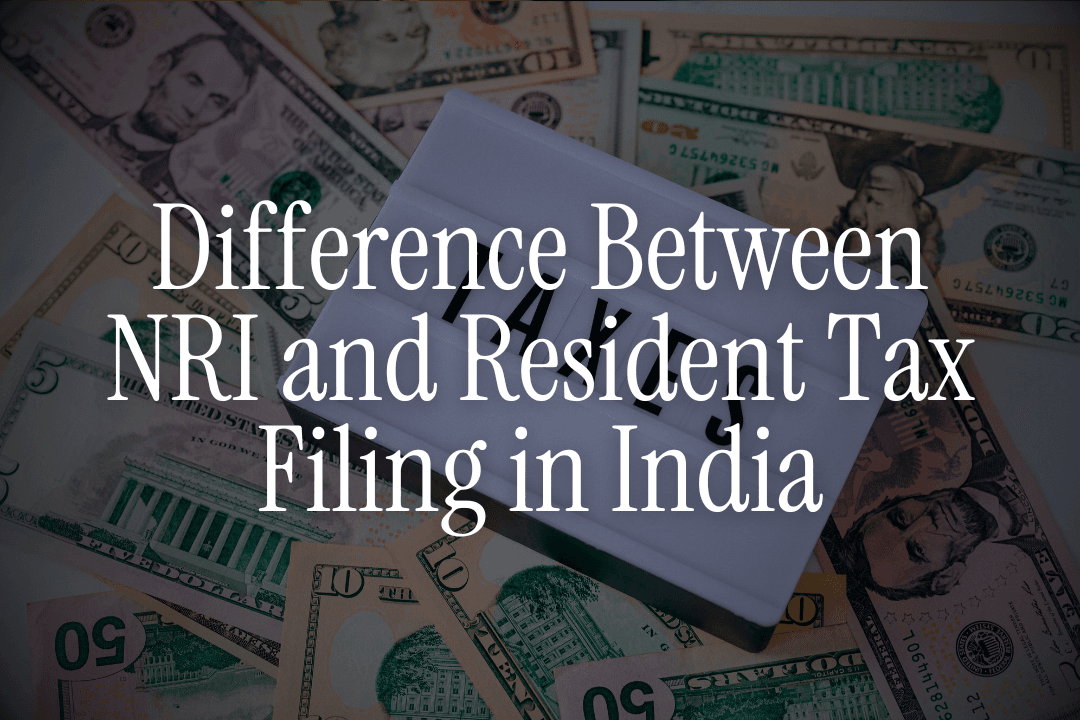
"Am I supposed to file as an NRI or a resident? I moved to Dubai in September, but I'm confused about my tax status for this year."
This question came from Meera during our Belong webinar last month. She'd been in Dubai for just 4 months, was earning both Indian and foreign income, and had no idea which tax category she fell into for FY 2024-25.
Here's what I told her: Your tax filing approach depends entirely on your residential status, which is determined by specific rules. Get it wrong, and you could face penalties or pay more tax than needed. Get it right, and you could save lakhs while staying fully compliant.
I'm Ankur Choudhary, and over 12 years of helping NRIs navigate Indian tax laws, I've seen how this one decision affects everything - from which forms to use to how much tax you pay.
By the end of this guide, you'll know exactly how to determine your status, which forms to file, what income gets taxed, and the key differences that could save you significant money on your Indian taxes.
Who Qualifies as NRI vs Resident: The Foundation of Everything
Before diving into filing differences, you must understand your residential status. This single determination changes your entire tax approach.
Resident Status Criteria
You're a Tax Resident if:
- You stay in India for 182+ days in the financial year, OR
- You stay 60+ days in current year AND 365+ days in past 4 years
Special Rules:
- Indian citizens abroad for employment: Only the 182-day rule applies
- High earners: If Indian income exceeds ₹15 lakh, the 60-day rule becomes 120 days
NRI Status Qualification
You're an NRI if:
- You don't meet either resident condition above
- You live abroad and visit India for less than 182 days
Real Example: Rajesh works in Abu Dhabi, visited India for 150 days in FY 2024-25. Even though he's an Indian citizen, he qualifies as NRI because he stayed less than 182 days and left for employment.
The Third Category: RNOR
Resident but Not Ordinarily Resident (RNOR) status applies if you're:
- Returning to India after being NRI for 9 out of last 10 years, OR
- Been in India for 729 days or less in past 7 years
Why RNOR Matters: You get NRI-like tax treatment for 3 years - only Indian income is taxed, not global income.
👉 Tip: Track your India visit days carefully each year. Even 3 extra days can change your entire tax liability category.
Tax Liability: What Gets Taxed for Each Category
This is where the biggest differences lie between NRI and resident tax filing.
NRI Tax Liability Scope
What's Taxable for NRIs:
- Income earned in India (salary for Indian work)
- Income received in India (even from foreign sources)
- Indian property rental income
- Capital gains from Indian assets
- Interest from NRO accounts
- Dividends from Indian companies
What's NOT Taxable for NRIs:
- Foreign salary staying in foreign accounts
- Interest from NRE accounts
- Foreign property income
- Foreign investment gains
Resident Tax Liability Scope
What's Taxable for Residents:
- Global income - both Indian and foreign
- All salary income (Indian and foreign)
- Worldwide property income
- International investment gains
- All bank account interest
DTAA Relief Available: Residents can claim foreign tax credit through Double Taxation Avoidance Agreements to avoid paying tax twice.
Practical Impact Example
Scenario: Ankit earns ₹30 lakh salary in Dubai + ₹8 lakh rental from Mumbai property
If NRI: Tax only on ₹8 lakh rental income
If Resident: Tax on ₹38 lakh total income
Tax Difference: Approximately ₹9 lakh additional tax as resident!
ITR Forms: Which One to File
The forms you can use differ significantly based on your status.
ITR Forms for NRIs
Form | When to Use | Income Types Covered |
|---|---|---|
ITR-2 | Most common for NRIs | Salary, property, capital gains, dividends |
ITR-3 | Business/professional income | Consultancy, freelancing from India |
Important: NRIs cannot file ITR-1 or ITR-4, even for simple income.
ITR Forms for Residents
Form | When to Use | Income Limit |
|---|---|---|
ITR-1 | Salary + one house property | Up to ₹50 lakh |
ITR-2 | Multiple income sources | No limit |
ITR-3 | Business/professional income | No limit |
ITR-4 | Presumptive taxation | Up to ₹50 lakh |
Key Advantage: Residents can use the simpler ITR-1 form for straightforward income situations.
Tax Rates and Slabs: Same Yet Different
Both NRIs and residents follow the same basic tax slabs, but with important differences.
Common Tax Slabs (FY 2025-26)
New Tax Regime (Default):
- Up to ₹4 lakh: Nil
- ₹4-7 lakh: 5%
- ₹7-10 lakh: 10%
- ₹10-12 lakh: 15%
- ₹12-15 lakh: 20%
- Above ₹15 lakh: 30%
Old Tax Regime:
- Up to ₹2.5 lakh: Nil
- ₹2.5-5 lakh: 5%
- ₹5-10 lakh: 20%
- Above ₹10 lakh: 30%
Key Differences in Tax Treatment
Section 87A Rebate:
- Residents: Get ₹12,500 rebate if income below ₹5 lakh
- NRIs: No rebate available
Age-Based Exemptions:
- Residents: Higher exemption limits for senior citizens (₹3 lakh) and super senior citizens (₹5 lakh)
- NRIs: Same ₹2.5 lakh limit regardless of age
Surcharge Rates: Both categories pay the same surcharge rates, but NRIs get relief on certain investment income types.
👉 Tip: NRIs often benefit more from the new tax regime due to limited deduction availability.
Deductions and Exemptions: Where the Real Differences Show
This is where residents have significant advantages over NRIs.
Deductions Available to NRIs
Section 80C (₹1.5 lakh limit):
- Life insurance premiums
- ELSS mutual fund investments
- Home loan principal repayment
- PPF contributions (if account opened before becoming NRI)
Section 80D:
- Health insurance premiums for self and family
- Medical insurance for parents
Property-Related:
- Standard deduction of 30% on rental income
- Interest on home loans for property purchase
Additional Deductions for Residents
Section 80TTA/80TTB:
- Savings account interest up to ₹10,000
- For senior citizens: ₹50,000 on deposit interest
Employment Benefits:
- HRA exemption
- LTA (Leave Travel Allowance)
- Standard deduction of ₹50,000 on salary
Investment Incentives:
- Additional deductions under various sections
- More flexibility in claiming exemptions
Practical Deduction Comparison
Example: ₹15 lakh total income with ₹2 lakh potential deductions
NRI: Limited to basic deductions, higher tax liability
Resident: Can claim full range of deductions, significant tax savings
TDS Rules: Different Rates for Different Status
Tax Deducted at Source rules vary significantly between NRIs and residents.
TDS Rates for NRIs
Income Type | TDS Rate | Notes |
|---|---|---|
NRO Interest | 30% | No threshold limit |
Rent Payment | 30% | Tenant must deduct |
Property Sale | 12.5% | Post July 2024 rate |
Professional Fees | 30% | As per Section 195 |
TDS Rates for Residents
Income Type | TDS Rate | Threshold |
|---|---|---|
Salary | As per slab | Projected annual income |
Bank Interest | 10% | Above ₹40,000 annually |
Rent Payment | 10% | Above ₹2.4 lakh annually |
Professional Fees | 10% | Above ₹30,000 per transaction |
Key Difference: NRIs face much higher TDS rates across most income categories.
Impact on Cash Flow
For NRIs: Higher TDS means more money blocked until ITR filing and refund processing.
Example: ₹10 lakh rental income
- NRI landlord: ₹3 lakh TDS deducted
- Resident landlord: ₹1 lakh TDS deducted
Filing Deadlines and Procedures
Both categories follow the same basic timeline, but with some nuances.
Common Deadlines
- Regular ITR Filing: September 15, 2025 (extended for FY 2024-25)
- Audit Cases: October 31, 2025
- Belated Returns: December 31, 2025
- Revised Returns: December 31, 2025
Documentation Requirements
For NRIs (Additional Requirements):
- Tax Residency Certificate for DTAA claims
- Form 10F for treaty benefits
- Proof of foreign residence
- NRE/NRO account statements
For Residents:
- Standard documents (Form 16, investment proofs, etc.)
- Foreign income details (if any)
- Foreign asset disclosure if applicable
Advance Tax Obligations
Both categories must pay advance tax if liability exceeds ₹10,000, but the approach differs.
For NRIs
Common Sources Requiring Advance Tax:
- Rental income from multiple properties
- Capital gains from asset sales
- Business income from India
Challenge: Estimating tax liability without clear income predictability from foreign employment.
For Residents
Salary Employees: Usually covered by TDS from employers
Others: Must pay quarterly installments on all income
Advantage: Better income predictability makes advance tax planning easier.
DTAA Implications
This is where NRIs often have more opportunities for tax optimization.
For NRIs
Higher DTAA Benefits:
- Since they're tax residents of foreign countries
- Can claim exemptions or reduced rates
- Particularly beneficial for UAE, Singapore, Mauritius residents
Common Benefits:
- Reduced withholding tax rates
- Capital gains exemptions
- Dividend tax relief
For Residents
Limited DTAA Benefits:
- Must prove foreign tax payment
- Can claim foreign tax credit
- Benefits mainly for foreign income
Process: More complex as they need to show taxes paid in multiple countries
👉 Tip: NRIs in UAE, Singapore, and Mauritius often get better DTAA benefits due to these countries' tax structures.
Banking and Investment Implications
Your tax status directly affects which financial products you can access.
For NRIs
Banking Options:
- NRE accounts (tax-free interest)
- NRO accounts (taxable interest)
- FCNR deposits (tax-free)
Investment Restrictions:
- Cannot open new PPF accounts
- Limited mutual fund options
- GIFT City investments available
Tax-Efficient Options:
- NRE fixed deposits for tax-free returns
- ELSS for Section 80C benefits
For Residents
Full Banking Access:
- All account types available
- Better interest rates on savings
- More loan products
Investment Flexibility:
- Complete mutual fund access
- All tax-saving instruments
- Real estate investments without restrictions
Common Mistakes and Penalties
Wrong status determination leads to specific types of errors.
Common NRI Filing Mistakes
Wrong ITR Form Usage: Filing ITR-1 instead of ITR-2 leads to rejection and penalties.
Missing Foreign Asset Disclosure: When transitioning from NRI to resident, failing to report foreign assets attracts severe penalties under the Black Money Act.
Incorrect DTAA Claims: Not filing Form 10F before claiming benefits results in claim rejection.
Common Resident Filing Mistakes
Not Reporting Foreign Income: Global income taxation means all foreign earnings must be reported.
Missing TDS Credits: Not claiming credit for foreign taxes paid leads to double taxation.
Penalty Structure
Wrong Status Filing: Interest at 1% per month plus penalties up to ₹5,000
Missing Disclosures: Up to ₹10 lakh penalty for foreign asset non-disclosure
Incorrect Claims: Penalty equal to tax sought to be evaded
Transitioning Between Statuses
Many NRIs face status changes during their careers.
NRI to Resident Transition
When It Happens:
- Returning to India permanently
- Exceeding 182-day stay threshold
- Children's education or family reasons
Tax Implications:
- Global income becomes taxable
- Must report worldwide assets
- May qualify for RNOR status for transition relief
Planning Strategies:
- Time the transition year carefully
- Utilize RNOR status if eligible
- Plan asset sales before becoming resident
Resident to NRI Transition
Common Triggers:
- Job transfer abroad
- Emigration for business
- Long-term foreign assignments
Tax Benefits:
- Foreign income becomes non-taxable
- Can open tax-efficient NRE accounts
- DTAA benefits become available
Documentation Needs:
- Proof of foreign employment
- Residence permits or visas
- Foreign address proof
Property and Capital Gains Treatment
Real estate transactions are treated differently based on your status.
For NRIs
Property Purchase:
- Can buy residential property (with some restrictions)
- Must follow FEMA guidelines
- Specific rules for property acquisition
Capital Gains Tax:
- Same rates as residents
- But TDS at time of sale differs
- Limited reinvestment options under Section 54
For Residents
Property Investment:
- No restrictions on purchase
- Full access to home loan benefits
- Better Section 54 exemption planning
Capital Gains Planning:
- More reinvestment options
- Better tax planning opportunities
- Lower TDS on sale transactions
International Income and Assets
This is where the biggest differences manifest.
NRI Treatment
Foreign Salary: Not taxable if earned and kept abroad
Foreign Property: Rental income not taxable in India
Foreign Investments: Capital gains from foreign stocks/funds not taxable
Resident Treatment
Global Taxation: All foreign income taxable in India
Foreign Tax Credit: Can claim credit for foreign taxes paid
Disclosure Requirements: Must report all foreign assets and income
Compliance Burden: Higher due to worldwide reporting requirements
Practical Filing Process Differences
The actual filing process varies based on your status.
For NRIs
Portal Access: Same income tax e-filing portal
Form Filling: Must indicate NRI status clearly Cannot select certain deduction sections Foreign asset schedules may be required
Verification: Can use Aadhaar OTP or EVC Digital Signature Certificate recommended for complex cases
For Residents
Simpler Process: More form options (ITR-1 for simple cases) Pre-filled data more comprehensive Better integration with bank statements
Additional Schedules: Foreign income schedules if applicable More deduction sections available
What This Means for Your Tax Strategy
Understanding these differences is crucial for optimizing your tax position.
Key Takeaways
Status Determination is Critical:
- Track your India visit days carefully
- Understand the 182-day rule and its variations
- Consider deemed residency implications
Form Selection Matters:
- NRIs must use ITR-2 or ITR-3 only
- Residents have more form options
- Wrong form selection leads to rejection
Tax Planning Opportunities Differ:
- NRIs benefit from territorial taxation
- Residents get more deduction options
- DTAA planning more beneficial for NRIs
Documentation Requirements Vary:
- NRIs need additional foreign residence proofs
- DTAA claims require specific forms
- Status transitions need careful documentation
Action Steps Based on Your Situation
If You're Currently NRI:
- Confirm your residential status annually
- Optimize your Indian banking structure (NRE vs NRO)
- Plan DTAA benefits properly
- Consider GIFT City investment options
If You're Currently Resident:
- Ensure all global income is reported
- Plan foreign tax credits effectively
- Use available deductions optimally
- Prepare for potential NRI transition
If You're Transitioning:
- Understand RNOR status benefits
- Time your status change strategically
- Plan asset restructuring if needed
- Update your banking arrangements
Professional Guidance: When You Need Expert Help
Given the complexity of these differences, professional help is often valuable.
DIY-Friendly Situations
For NRIs:
- Single source of Indian income
- Straightforward rental or investment income
- Standard DTAA country residence
For Residents:
- Salary income with basic deductions
- No foreign income or assets
- Simple investment portfolio
When to Consult Experts
Complex Situations:
- Status transitions during the year
- Multiple income sources
- Significant foreign assets
- DTAA optimization opportunities
- Property transactions
Cost vs Benefit: Professional fees of ₹10,000-25,000 can often save multiples through proper planning and compliance.
Bottom Line: Your residential status fundamentally changes how you file taxes in India. Get this determination right first, then everything else - forms, rates, deductions, and compliance - follows logically.
Need personalized guidance? Our tax experts specialize in both NRI and resident tax situations. Whether you're transitioning between statuses or optimizing your current position, we can help you navigate these differences effectively.
Join our NRI community for status-specific tax tips, or explore our GIFT City investment options designed specifically for tax-efficient NRI investing.
This guide covers tax filing differences for FY 2024-25 and FY 2025-26. Tax laws and residential status rules can change. Always verify your specific status and compliance requirements with qualified tax professionals.




